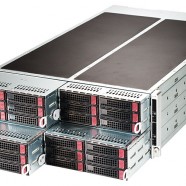Supermicro, VSAN and EVO:Rail
Podcasting for Cancer Champion: Supermicro!
Supermicro and VMware have released a new generation of VMware EVO:RAIL appliances and VMware Virtual SAN Ready Nodes. The arrival of the new Supermicro servers is occurring alongside the release of VMware’s vSphere 6.0 suite, which is VMware’s most important release in several years. Combined, the Supermicro and VMware launches are more than simply an incremental improvement and serve as an exceptional showcase for the power and flexibility the modern software defined datacenter is capable of delivering.
The 2015 generation of Supermicro servers that have been specially designed with VMware’s VSAN and EVO:RAIL in mind are the 2U TwinPro² and the 4U FatTwin series servers. Supermicro’s various partners have led the industry in delivering hyperconverged solutions using previous generations of Twin series servers. Lessons learned there, combined with the increased capability of the next generation of VMware software, have driven the design of the next generation Supermicro Twin series servers.
Increments of change
A generational change can occur either because a major feature is introduced, or through a series of iterative implements that, combined, result in a significantly superior product. The 2015 Twin series servers have done both.
Supermicro hasn’t simply relied on evolving standards and new generations of equipment being made available by upstream partners. The quality of Supermicro servers (which Supermicro feels was already quite good) has been significantly improved. Supermicro is constantly working with customers and partners to identify design elements that need improvement, and the 2015 servers are the result of many such changes.
The most notable incremental improvement will be found in the addition of Supermicro’s Titanium Level high-efficiency digital power supplies (more detail below) and architecture designs that improve airflow for optimal cooling. In addition to these green computing improvements, the rail kits have undergone several design tweaks that make the next 2015 lineup easier to rack, derack and generally physically manage in the datacenter.
Additional tweaks will be found in everything from sled removal flanges to drive trays. There has been a fairly major update to the baseband management controller software resulting in a better IPMI experience, especially when using IPKVM. Individually each of these improvements means little; combined, they make the 2015 Twin series much nicer to work with.
In terms of major changes, the 2015 Twin series lineup features Intel Xeon E5-2600 v3 CPUs, DDR4, hot-swap NVMe, virtualized GPUs and high efficiency digital power supplies. Individually each of these technologies would set a new bar for capability, performance and flexibility in the datacenter. Combined, they make 2015’s servers a completely different animal than those that were available even a few months before.
Grantley
Intel’s Xeon v3 “Grantley” processors are, simply put, amazing. Xeon v3 processors are based on Intel’s wildly successful 22-nm “Haswell” consumer facing CPUs and feature the first generation of Intel’s “3D” tri-gate transistors. Intel’s Xeon v3 processors enable the use of DDR4, which offers more memory bandwidth than its predecessor, DDR3.
Xeon v3 processors can have up to 18 cores per socket. That is 36 threads per socket or 72 threads in a standard 2 socket server. That gives us 288 threads in both the 2U, 4 node TwinPro² EVO:Rail appliance and the 4 node, 4U VSAN ready FatTwin. For those stepping outside the officially certified VSAN solutions, it is possible to achieve a mind blowing 576 threads in a 4U, 8 node FatTwin!
Supermicro’s EVO:RAIL Appliance (SYS-2028TR-VRL001/002) comes with 14.4TB raw capacity between the 10K RPM drives as well as cache SSDs. Thanks to the power of the Intel Xeon v3 processors it can handle up to 100 general purpose server virtual machines or 250 virtual desktops per appliance.
The VSAN Ready clusters can handle heavier workloads, as would be expected from them being 4 nodes in 4U instead of 4 nodes in 2U. The flagship offering (SYS-F628R3-VSN002L) boasts 33.6TB RAW across its 10K RPM HDDs. It supports 512GB of RAM per node, so in addition to getting 288 threads across the 4 nodes chassis there is 2TB of RAM in which to run workloads. The end result is a 4 node FatTwin that supports up to 250 general purpose server virtual machines or 400 virtual desktops.
NVMe
NVMe support is a major element of the 2015 Supermicro lineup. NVMe is the successor to both SATA and SAS technologies. Essentially a response to the proliferation of PCIe SSDs, NVMe allows SSDs to connect to servers at PCIe speeds while still being hot swappable.
NVMe is more than just a faster interconnect for storage. NVMe allows for a far greater queue depth than SATA’s AHCI (NVMe has 65,536 commands per queue and 65,536 queues versus 32 commands per and only one queue for AHCI). The end result is that disk utilisation of NVMe SSDs is much higher than is practicably obtainable with traditional SATA or SAS.
This also means that the new generations of NVMe SSD drives can be designed with larger caches. Larger caches allow SSDs to be more efficient about how they write blocks, increasing SSD write life and making SSDs more viable for high-intensity server workloads.
Enterprise Support
Though many don’t know it yet, Supermicro does offer full enterprise support. Long viewed merely as a whitebox shifter, or builder of systems for OEMs, Supermicro has built a worldwide 4-hour enterprise support mechanism the equal of any of its major rivals.
Supermicro recognises that hyperconverged solutions are a major departure from traditional datacenter designs. For many customers, Supermicro-provided enterprise support is a key consideration, especially if they are being asked to consider Supermicro-branded EVO:Rail appliances or VSAN Ready nodes.
Supermicro’s enterprise service team has now offered 4-hour onsite response for over a year. This complements the next business day and integration services tiers that round out Supermicro’s support offerings. 4-hour onsite response offers a 24×7 point of contact while next business day offers a standard 8-hour business day x 5 days point of contact.
Airflow Optimization and 80 Plus Titanium
One of the aspects of server design which gains Supermicro the most praise is “green computing” engineering efforts. This ranges from high end power supplies to energy efficient design.
There is a finite amount space to work with in a modern high-density server. Supermicro puts a high level of effort into design and layout of components on their motherboards to achieve optimal airflow through the system. The end result is lower temperatures on the various server components which increases overall performance and reliability.
Supermicro can run higher watt CPUs at higher ambient temperatures than many of their competitors. This can result in cost savings on cooling as all-Supermicro data centers can be run at higher temperatures. The increased performance per watt, when scaled out across thousands of nodes, not only provides lower TCO, but is also a core part of Supermicro’s environmentally aware philosophy of green computing.
Supermicro’s power supplies, designed and built by Supermicro, are industry leading in terms of efficiency and reliability. Supermicro’s new digitally switched, 80 Plus Titanium power supplies can be found offering up to 96% efficiency. More efficient power supplies means more power used by servers for productive purposes and less power lost unproductively as heat within the power supply. More critically, 80-plus power supplies must meet minimum standards of efficiency at various levels of utilisation.
Power supplies are not uniformly efficient. A power supply which is only being used to 10% of its capacity will be far less efficient than one being used at half capacity. Similarly, the power supply efficiency curve tends to mean that as you push past 50% of the rated capacity the efficiency drops as well.
80 Plus Titanium power supplies must meet a minimum efficiency of 90% at 10% load. This makes an 80% Titanium power supply more efficient at only 10% load than the minimum requirement for 80 Plus Gold certification at peak efficiency. 80 Plus Titanium power supplies must also meet a minimum of 94% efficient at 50% load, and Supermicro has not only met this requirement with the new power supplies, but in many cases exceeded it.
Better efficiency means less power lost as useless heat. Less heat means lower cooling bills, and it also means less wear and tear on the power supplies themselves. The newer, more efficient power supplies have longer productive lives than their predecessors, minimising the number of outages due to power supply failure.
Ready for the big leagues
It is no small thing for a server vendor to claim they are ready to sell and support hyperconverged solutions under their own name. Hyperconverged solutions incorporate storage and compute into a single package, often including software defined networking as well.
This means hyperconverged solutions are more than just “yet another generation of servers”. They are taking on the role of hardened enterprise solutions ranging from rack mount compute nodes to blades to enterprise SANs and even providing many of the functions traditionally assigned to high end switches.
Hyperconverged offerings need to be able to deliver fantastic performance with tip-top support and as close to 100% rock solid as modern technology is able to make them. With the 2015 Twin series servers, Supermicro delivers exactly this.
A generational change in computing starts with something as simple as the design of a rail kit and it ends with the delivery of server gear good enough to bet the business on. Supermicro is betting on the Twin series servers, and that’s why 2015 is starting with Supermicro-branded VMware EVO:Rail and VSAN ready nodes. Supermicro is ready not just for the big leagues, but for your datacenter as well.
Podcasting for Cancer is trying to help fellow Spiceworks community member – and friend of WeBreakTech – Phillip Lessley and his family deal with the fallout of a particularly nasty cancer. Their lives have been turned upside down and things seem to be constantly going from bad to worse. If you don’t know what I’m talking about please click here to learn more. If you can, help out either through donations or by volunteering to write blogs or participate in podcasts.
Supermicro loves the Spiceworks community and all of its Spiceheads. When I reached out to them about this, they immediately stepped out to the plate. They have contributed significantly towards the cause.
This then is the first blog delivered as part of the 2015 Podcasting for Cancer campaign. I wrote it myself, and it is about Supermicro’s next 2015 generation of VMware EVO:Rail and VSAN ready servers. Thank you, Supermicro, and thank you to everyone who took the time to read this blog.
- Information Overload? There’s an app for that. - January 12, 2017
- Year end thank yous - December 23, 2016
- Archival cloud storage can be an affordable backup layer - October 3, 2016
- On the importance of the user experience - August 13, 2016
- Beyond the traditional storage gateway - June 17, 2016
- Data residency made easy - June 15, 2016
- DevOps shouldn’t be a straitjacket - March 15, 2016
- Preparing for Office 2016 - November 7, 2015
- Supermicro, VSAN and EVO:Rail - February 4, 2015
- Make a #WebScaleWish - November 21, 2014







